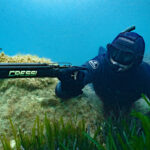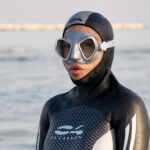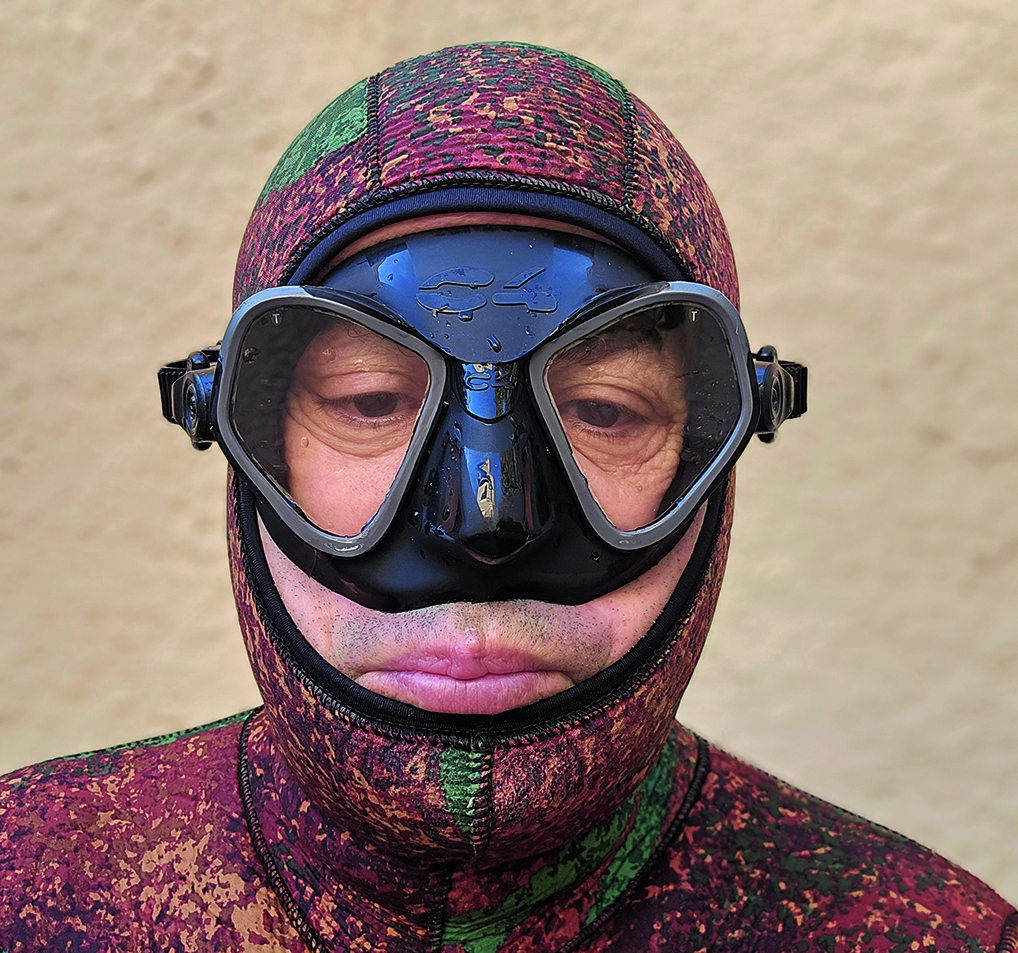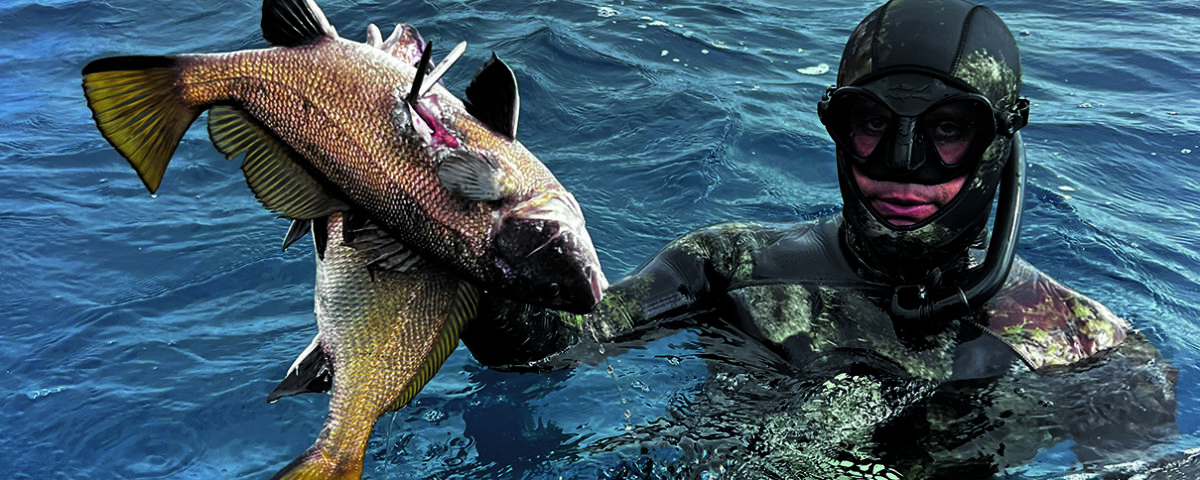The Mask That Doesn’t fog up has arrived

Cressi: Victory 90
20 February 2025
C4: Sideral wetsuit for women
27 February 2025We're talking about the Condor by C4 in its brand-new Antifog version. A special film applied to the inside of the lenses effectively prevents this extremely annoying phenomenon
Gherardo Zei
Everyone knows that I’m neither a champion nor a great technician—just someone with an immense passion for spearfishing, to which I’ve already dedicated more than thirty years of my life. Knowing our community, I’m not an exception at all; in fact, I’m more of a prototype of the “common” spearfisher, because almost everyone in the silent majority is like me: humble enthusiasts who go out to sea regularly. And perhaps this kind of "people’s tribune" role is what has put me in the position to write for our historic magazine uninterruptedly for the past thirty years.
This introduction is just to clarify that the story I’m about to tell you about the gradual fogging of masks over the past twenty years has nothing to do with a scientific or industrial reconstruction of what happened. It’s simply an account of the growing frustration (to put it mildly) among all spearfishers due to the inexplicable and persistent increase in the fogging of lenses across almost all major brands. Even worse, swimmers have suffered even more, as they are less capable than us in trying to counteract the phenomenon.
But what exactly happened? It’s hard to say—that’s something the manufacturers and technical scientists should explain to us. All I can do is describe the situation we ordinary spearfishers have found ourselves in.
Back to the beginning. About forty years ago, I used a rubber mask from Technisub, and systematic fogging wasn’t even a concept I was aware of. You’d spit on the lenses, rinse them, and jump into the water. Some more refined individuals suggested carrying half a potato to rub on the lenses instead of using saliva, but practically no one actually did that. The masks were made of rubber, maybe a bit stiff, but we all survived. And so, we were happy.
The arrival of silicone
Then came progress—and with it, silicone. Sure, silicone is much softer (though sometimes too soft, and at depth, with certain models and certain facial structures, the frame can press against your forehead, causing pain). Because of this flexibility, silicone masks fit the face more easily. However, with silicone came the first fogging problems.
There were heated debates on mailing lists and forums about finding solutions to this issue. Honestly, I was in the “camp” that believed progress doesn’t always improve life and that things were better before. But I was in the minority because humans tend to adapt. I resisted for a few years, searching for my old rubber mask—by then out of production—among leftover stock (a well-known champion held out even longer than I did), but eventually, I gave in.
Some manufacturers continued to release rubber models, but choosing a mask is a very personal matter. Each person has to wear what fits them best, and if those models were only made in silicone, adaptation was the only option. By that point, nearly all production was in silicone, so we all had to adjust.
For a while, it seemed the problem was somewhat resolved. Essentially, a new mask required a cleaning period after purchase, and after this “initiation,” the lenses would hardly fog up anymore. The most common procedures involved flaming the lenses with a lighter, followed by cleaning them with toothpaste—a process that sometimes had to be repeated multiple times. Some people used other products, like Sidol, but the goal for everyone was to remove the initial film and prevent fogging.
Personally, I even developed a system: I always kept three identical masks—one in use, one as a primary backup, and another as a secondary backup. I treated them all with the flaming-and-toothpaste method, but while I wore the first one every week, the other two were reserved for relaxed summer swims. This way, when the primary mask wore out and had to be replaced, I always had at least one that was already “broken in” and ready to use.
The deterioration of the situation
I don’t think I will be contradicted if I say that, however, in the years that followed, the new silicones used by manufacturers became progressively more prone to fogging, to the point that cleaning procedures began to show their limits, and a mask, even if treated for a long time, never completely stopped fogging. On the contrary, after a while, it surprisingly started to get worse again.
The frustration, not just mine but that of many others, even those much more skilled than me, started to become overwhelming. At a certain point, I found myself having to use a special anti-fog solution before every dive. The same companies that produced the masks sold anti-fog solutions, and I’ve always felt bad about that. If I buy such a simple object, I think it should be "ready-to-dive" and not require extra steps or additional expenses. Moreover, it seemed (and still seems) absurd to me that to create an object made primarily of two materials (glass and rubbery material), they would choose two materials in such a way that one (the rubbery material) would compromise the functionality of the other (the glass). This is something I still can't explain.
In short, our reasonable request for a mask that wouldn't fog seemed unsolvable. I had a heart-to-heart conversation with a well-known manufacturer who told me that, with the silicones used, fogging could still occur even after years, regardless of any treatments applied.
Those who know me understand that it’s not my nature (and certainly not my habit) to stir up controversies, but faced with such a ridiculous situation, I sparked a couple of “flames” on Facebook where I strongly criticized the manufacturing companies (all of them, not just one).
Then, one day, Marco Ciceri sent me a message. The gist was that at C4 they were solving the problem and would send me the prototype. And that’s what happened.
The solution
I received a Condor (a model I had previously tried in a store to check how it fit my face) with the anti-fog treatment, which I’ll tell you about later.
The first thing I did was to test the Condor Antifog dry, comparing it to two other new masks: one made of rubber and one made of untreated silicone. Three new models, none of which had been in the water, to be tested equally.
I blew air into all three masks with my nose. Doing so, only the untreated silicone mask fogged up. Then I exhaled into them, and both the untreated silicone and rubber masks fogged up, while the Condor Antifog just got wet. Finally, I waited a few minutes to see if the fogging would disappear.
Within two minutes, the rubber mask was back to normal, the Condor Antifog stayed perfect, while the untreated silicone mask remained fogged. To be more precise, the right lens of the untreated silicone mask improved slightly, while the left one remained completely clouded by the fogging. A situation I know well, unfortunately, because I’ve experienced it many times before with untreated silicone models right after purchase.
Sea trial
Finally, I took the Condor Antifog into the sea, and below I’ll give you a detailed account of the objective outcome and the sensations I experienced. But I want to start my story from the end, quoting the message I sent to Ciceri right after coming back from the sea.
“I just got back. It worked. It’s fantastic. I had amazing sensations. With regular masks, even after cleaning them with the anti-fog product C4, I’d still get those small spots in the top corners, which didn’t really affect my fishing but were very annoying for me. With this one, though, nothing. It was like a mirror from start to finish. Plus, it fits my face perfectly. I’m not taking it off anymore; you’ll get an amazing review.”
Sensations and reflections in the water
I entered the sea from the shore on a calm day with clear water. When I went to put the mask on, I had a moment of uncertainty, which is inevitable when trying a new model for the first time. I had wet the mask before putting it on, but hadn’t done any other treatment or spat in it.
At that point, I put my head under the water and had that classic moment of anxiety that we all know too well: will it fog up or not? It seemed fine, but I felt a little unsure, as though the view was slightly magnified. However, after a few moments, I realized that the reason for this was probably because the Condor has a wider field of vision than my usual one.
After a few minutes, everything was fine. The mask fit perfectly and didn’t let any water in, so I started fishing calmly. About an hour later, I thought about the mask again, and I was amazed. There was no sign of fogging, not even in the corners. It’s common for tiny spots to form in the outer top corners or even inside the lens near the nose. These are so small they don’t affect performance, but you can’t imagine how much they’ve stressed me out over the years. Especially in summer, with the heat, these spots can sometimes expand and become annoying.
I was happy. Also, because the Condor fit my face perfectly. So, I left it in my fishing bucket instead of my previous model.
Some explanations
When I got home, I chatted with Marco Ciceri, who gave me some additional explanations. The treatment consists of a film applied to the inside of the lenses: the same principle as the visors on motorcycle helmets or ski masks, but designed for use in water, not air. That’s why the inside of the lenses should not be “touched” in any way: for example, no fingerprints that leave skin oil.
The C4 models with these anti-fog films will include, in addition to the Condor in all its versions, the Falcon in its black version.
There are three densities of silicone. The one I tested is softer than rubber but less so than many other silicones, and I found it perfect for my needs.
The advice is to use the old saliva method to clean it before entering the sea and, after use, if you want to be thorough, you can wash it in fresh water with a little soap and then dry it with a clean cloth (this procedure is particularly recommended if the mask is used in a pool).
Conclusions
I’d say we’re looking at a perfect anti-fog solution. Since it’s a treatment with a film, the only thing to monitor is the duration of the film, which is still unknown. We know that several of the masks tested since June 2024 have exceeded 100 outings between sea and pool without any issues. Anyway, the film can be replaced, but this operation can only be done by C4 or specialized stores. It’s not particularly difficult, but it requires the right tools.



